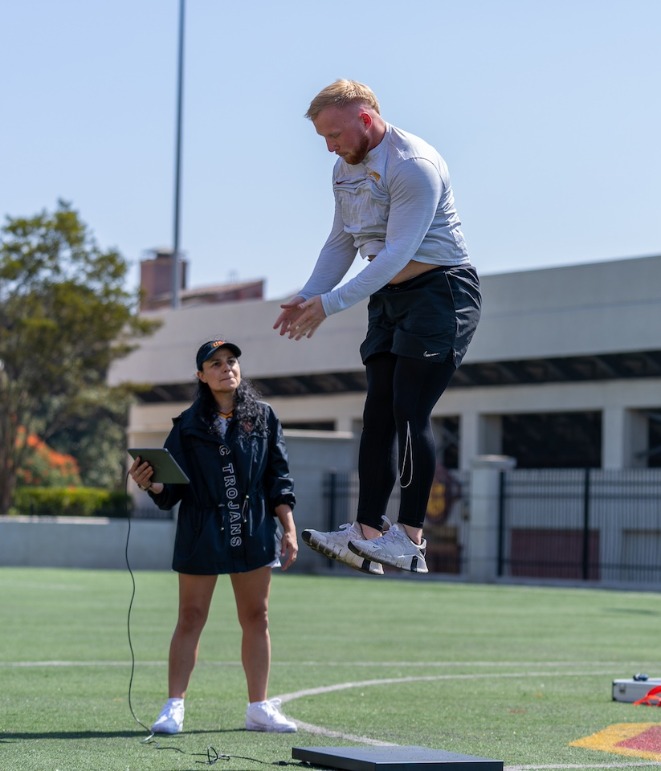
Dean Geoff Garrett on the Future of AI in Higher Ed
Dean Garrett speaks about the University’s AI Strategy Committee, which he’s leading in efforts to integrate AI across multiple disciplines.
Changing the Dynamics of Sports Performance Analytics
Changing the Dynamics of Sports Performance Analytics
Data scientist Lorena Martin teaches students to code, analyze, and communicate data for athletic performance, injury prevention, and career longevity.

Assistant Professor Lorena Martin guides students through a series of assessment technologies as part of the class’ hands-on learning experiments; pictured is student Nick Adgar performing a vertical jump.
[USC Photo / Grayson Adler]
“Can I still play?” For an injured athlete, a season, a career, even a franchise may all hinge on the response to those four words.
Lorena Martin, assistant professor of clinical data sciences and operations, is preparing the next generation of experts in the field who can answer that game-changing question with facts and strategy.
Ultimately, the answer can be based on a complicated list of data inputs and assessment technologies by a sports performance analyst. But the coach isn’t interested in the behind-the-scenes complexities of data collection — they just want a simple yes or no — and the athlete wants to know about the risk of injury and readiness to play.
As part of Marshall’s growing curricular emphasis on the business of sports, DSO 499 Sports Data Science and Management (undergrads), DSO 578 Fundamentals of Sports Performance Analytics (graduates basic level) and DSO 579 Advanced Sports Performance Analytics (graduates advanced level) focus on data’s role in athletic performance and career sustainability.
A former elite athlete turned data scientist, Martin has developed these classes from her previous experience as a director of sports performance analytics for the Los Angeles Lakers as well as research for her book on the subject and her current work as a consultant for professional athletes and teams across leagues nationally and internationally.
Learning not only what to measure and why, Martin’s classes teach students how to code, analyze, and communicate data-driven decision-making for actionable results. Students learn to build and apply statistical models for pro sports industry business applications, implement machine learning directed toward various sports scenarios, and analyze publicly available data to assess and predict performance outcomes.
Martin contends the AI revolution will transform sports, for better and for worse. As more data becomes available, analysts will likely struggle with misinterpretations and errors until refined algorithms are created with greater accuracy and for ease of interpretation.
“A lot of people can leverage it accurately. But then you don’t have the people that have been well trained to interpret it. Marshall is changing that dynamic,” Martin stated. “In this class, students are learning how to train and evaluate machine learning models.
The interactive classes have students learning how to code and use open-source programming languages including Python and R.
In this class, students are learning how to train and evaluate machine learning models ... What other way would you prefer to learn stats and coding?
— Lorena Martin
Assistant professor of clinical data sciences and operations
They’re also working to capture data by applying the latest, most advanced technological tools including Kinvent digitized hand-held dynamometers (K-Grip), electromyography wireless sensors (K-Myo), Sparta Science force plates, and K-Deltas, which measure upper body strength, muscle activation and electrical activity of the motor units, anaerobic power, balance, range of motion (K-Move), and isometric strength (K-Push and K-Pull), as well as timing gates to determine running speed. These hands-on learning opportunities help students quantify the physical assessments needed for an athlete to improve performance and prevent injury.
Martin believes there’s more to sport analytics than numbers and spreadsheets, especially when it comes to communicating the results to the player or ball club. Less is sometimes more.
“You do all the work and you need to know how to do it correctly. But then also, you need to know how to correctly communicate the results: maybe a couple of well thought out words to the player or coach, but more detailed and thorough communication to front office executives,” Martin explained. “To the player, you have to understand what you should not tell them and what you should tell them.”
Martin’s classes attract sports fan students who need to improve on their data analytic and coding skills, but also science and engineering-focused students who don’t have experience with athletics.
“All students need to learn how to collect data and analyze it correctly. This is a fun way to do it,” Martin added. “What other way would you prefer to learn stats and coding?”
Data analytics is a fast-growing aspect of sports business, projected to be a $14 billion industry by 2029. The field offers real-time relevance to professional athletes: how they play, throw, step, eat, drink, and sleep are all keys to the individual’s performance.
“When I consult with teams and players, I’m focused on helping them reduce the risk of injury and improve sports performance and career longevity,” Martin explained. “Tom Brady. LeBron James. How do we get other athletes to go the distance like they have?”
In fact, Martin has a prediction based on the numbers she’s analyzed.
“Ninety-five percent based on my data, LeBron and Tom Brady could go further. I know I’m going to get a lot of heat for this. But yes, Tom Brady could come out of retirement one more time,” Martin said.
And LeBron?
“I ran the analysis and saw that he could technically go approximately four more years at a high level,” she added. “But it depends on his own motivation and at what standard he’s willing to continue to perform.”
Martin isn’t basing her prediction on her L.A. fandom. She’s using analytics, wearable tech, and A.I. — the same tools and skills her students are learning in her classes.
Learning not only what to measure and why, Professor Lorena Martin’s classes teach students how to code, analyze, and communicate data-driven decision making for actionable results.
Professor Lorena Martin provides instructions to student Riley Sansone before learning how to test an athlete for balance symmetry.
Student Nick Adgar prepares to do a vertical jump as part of the many tech assessment tools Professor Lorena Martin uses in class to teach sports performance analytics
Assistant Professor Lorena Martin guides students through a series of assessment technologies as part of the class’ hands-on learning experiments; pictured is student Nick Adgar performing a vertical jump.
RELATED
Dean Geoff Garrett on the Future of AI in Higher Ed
Dean Garrett speaks about the University’s AI Strategy Committee, which he’s leading in efforts to integrate AI across multiple disciplines.
Marshall Faculty Publications, Awards, and Honors: October 2025
We are proud to highlight the many accomplishments of Marshall’s exceptional faculty recognized for recently accepted and published research and achievements in their field.
Sports Leaders Discuss Athlete Business Savvy, LA28, and Student Learning Opportunities at Next Level Sports Conference
Roger Goodell, Maria Sharapova, Chris Paul, and Casey Wasserman spoke at the second annual NLS Conference, hosted by USC Marshall and USC Annenberg.
AI Bottlenecks: A Q&A with Georgios Petropoulos on Obstacles to an Economic Boom
Assistant Professor Georgios Petropoulos discusses his research on artificial intelligence bottlenecks and the factors preventing the technology from catalyzing an economic surge.
Alumni Honor Founding MBV Director Robert Turrill with Commemorative Plaque
Through mentorship and commitment, the founding director of the Master of Business for Veterans’ program has inspired Trojans in and out of the classroom.